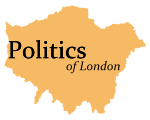

| This article is part of a series within the Politics of England on the |
| Politics of London |
|---|
 |
The London congestion charge is a fee charged on most cars and motor vehicles being driven within the Congestion Charge Zone (CCZ)[2] in Central London between 7:00 am and 6:00 pm Monday to Friday, and between 12:00 noon and 6:00 pm Saturday and Sunday.[3][4]
Inspired by Singapore's Electronic Road Pricing (ERP) system after London officials had travelled to the country, the charge was first introduced on 17 February 2003.[5] The London charge zone is one of the largest congestion charge zones in the world, despite the removal of the Western Extension which operated between February 2007 and January 2011. The charge not only helps to reduce high traffic flow in the city streets, but also reduces air and noise pollution in the central London area and raises investment funds for London's transport system.
The standard charge is £15, Monday–Friday from 7:00 am to 6:00 pm, and 12:00 noon to 6:00 pm on Saturday and Sunday (and Bank Holidays), for each non-exempt vehicle driven within the zone, with a penalty of between £65 and £195 levied for non-payment.[4] The congestion charge does not operate between Christmas Day (25 December) and New Years Day (1 January) inclusive.[6] In July 2013 the Ultra Low Emission Discount (ULED) introduced more stringent emission standards that limit the free access to the congestion charge zone to all-electric cars, some plug-in hybrids, and any vehicle that emits 75 g/km or less of CO2 and meets the Euro 5 standards for air quality.[7][8] On 8 April 2019, the Ultra Low Emission Zone (ULEZ) was introduced, which applies 24/7 to vehicles which do not meet the emissions standards:[9] Euro 4 standards for petrol vehicles, and Euro 6 or VI for diesel and large vehicles. In October 2021, the ULEZ was expanded to cover the Inner London area within the North and South Circular Roads,[10] and in August 2023 to all of Greater London. The ULEZ replaced the T-charge (toxicity charge) which applied to vehicles below Euro 4 standard.[11][12] Since 2021 the congestion charge exemption has applied only to pure electric vehicles and from 2025 there will be no discounts for electric vehicles.[13]
Enforcement is primarily based on automatic number-plate recognition (ANPR). Transport for London (TfL) is responsible for the charge which has been operated by IBM since 2009. During the first ten years since the introduction of the scheme, gross revenue reached about £2.6 billion up to the end of December 2013. From 2003 to 2013, about £1.2 billion has been invested in public transport, road and bridge improvement and walking and cycling schemes. Of these, a total of £960 million was invested on improvements to the bus network.
The congestion charging scheme possibly facilitated[14] a 10% reduction in traffic volumes from baseline conditions, and an overall reduction of 11% in vehicle kilometres in London between 2000 and 2012, though these changes cannot be causally attributed to the congestion charge.[14] Despite these gains, traffic speeds have also been getting progressively slower over the past decade, particularly in central London. TfL explains that the historic decline in traffic speeds is most likely due to interventions that have reduced the effective capacity of the road network in order to improve the urban environment, increase road safety and prioritise public transport, pedestrian and cycle traffic, as well as an increase in road works by utilities and general development activity since 2006. TfL concluded in 2006 that, while levels of congestion in central London are close to levels before the congestion charge was implemented, its effectiveness in reducing traffic volumes means that conditions would be worse without the congestion charging scheme,[15] though later studies emphasise that causality has not been established.[14]
- ^ "Traffic in the City 2018" (PDF). Department of the Built Environment. February 2018.
- ^ "CCZ abbreviation stands for Congestion Charge Zone". All Acronyms. Caleb Cox. Retrieved 12 April 2015.
- ^ "Congestion Charge (Official)". Transport for London. Archived from the original on 12 April 2015. Retrieved 12 April 2015.
- ^ a b "Coronavirus: London congestion charge brought back with price rise". BBC News. 15 May 2020.
- ^ Simon Jeffery & Sarah Phillips (7 August 2006). "Q&A: The congestion charge". The Guardian. Guardian News and Media. Retrieved 26 May 2007.
- ^ "Maps & Times". Transport for London. Archived from the original on 23 January 2008. Retrieved 16 February 2013.
- ^ Cite error: The named reference
ULEDwas invoked but never defined (see the help page). - ^ Cite error: The named reference
Sunset2016was invoked but never defined (see the help page). - ^ "Complying with ULEZ - Transport for London". Archived from the original on 17 August 2018. Retrieved 18 January 2019.
- ^ "London Mayor confirms Ultra-Low Emission Zone will start in 2019". www.fleetnews.co.uk. Archived from the original on 25 July 2019. Retrieved 26 November 2017.
- ^ Cite error: The named reference
TChargewas invoked but never defined (see the help page). - ^ Cite error: The named reference
TCharge02was invoked but never defined (see the help page). - ^ Cite error: The named reference
:0was invoked but never defined (see the help page). - ^ a b c Givoni, M. (2011). Re-assessing the Results of the London Congestion Charging Scheme. Urban Studies, 49(5), 1089–1105. doi:10.1177/0042098011417017
- ^ Transport for London (TfL) (January 2014). "Public and stakeholder consultation on a Variation Order to modify the Congestion Charging scheme Impact Assessment" (PDF). TfL. Retrieved 15 February 2015. See pp. 12: Traffic volume, speed and congestion.
